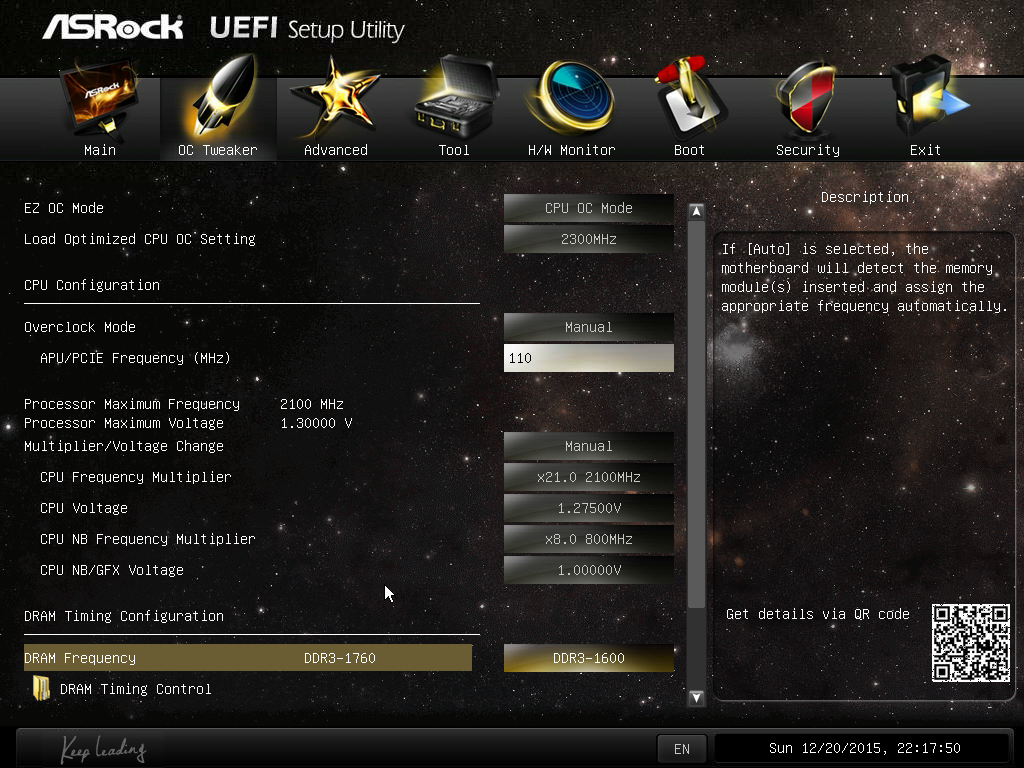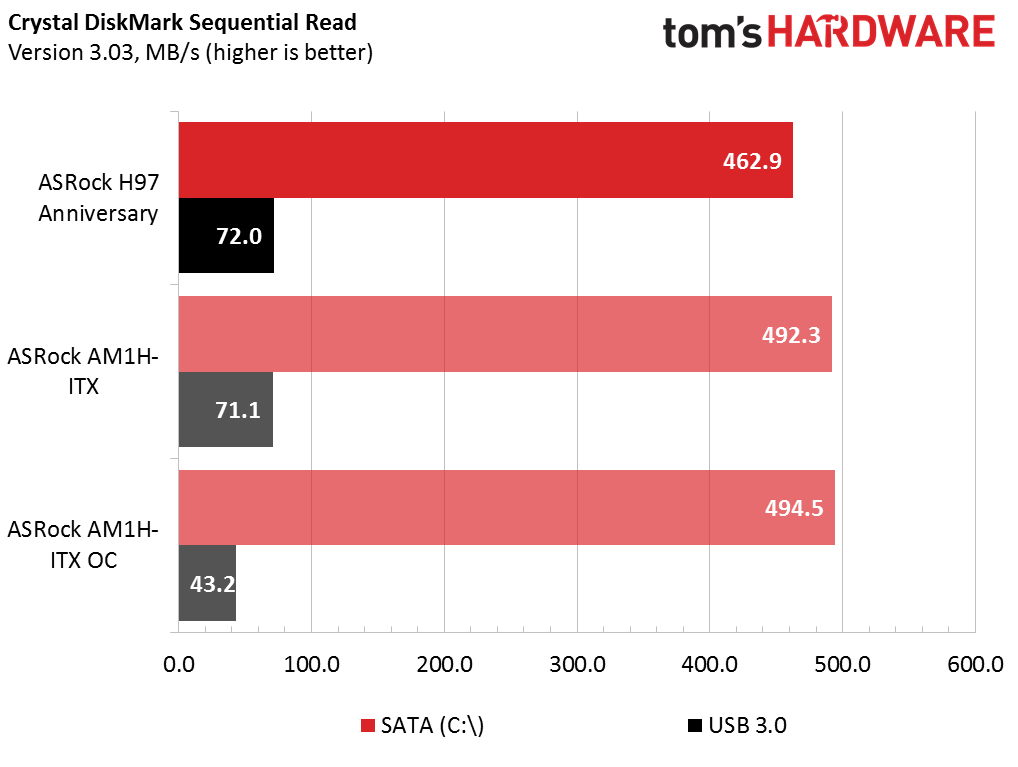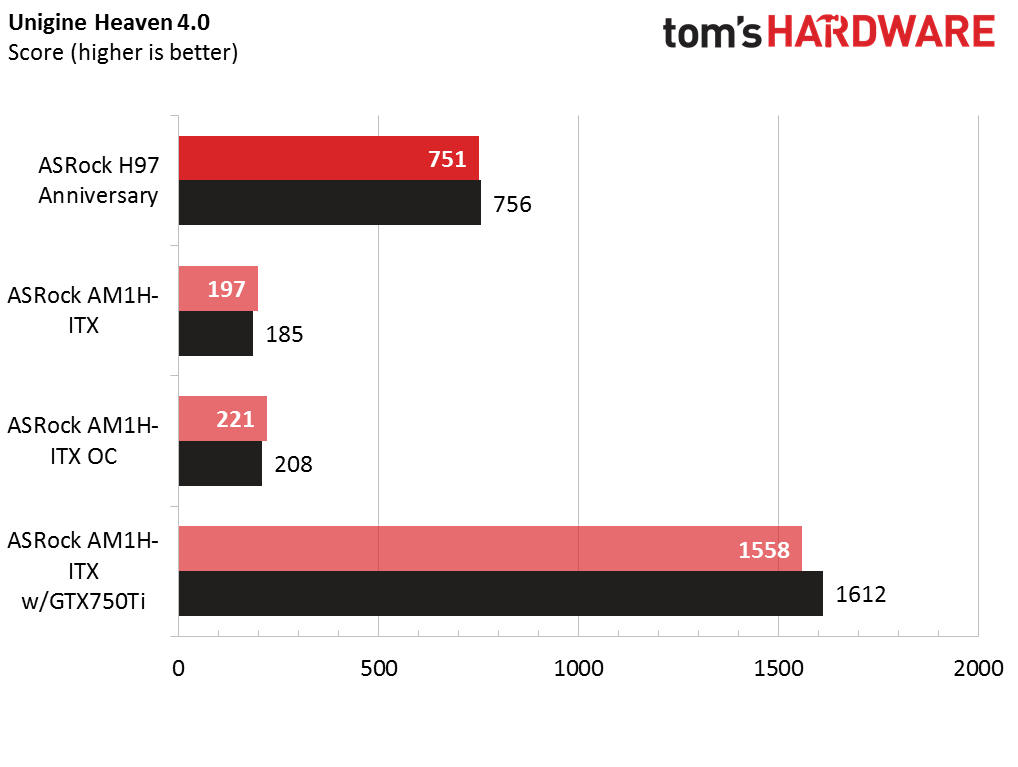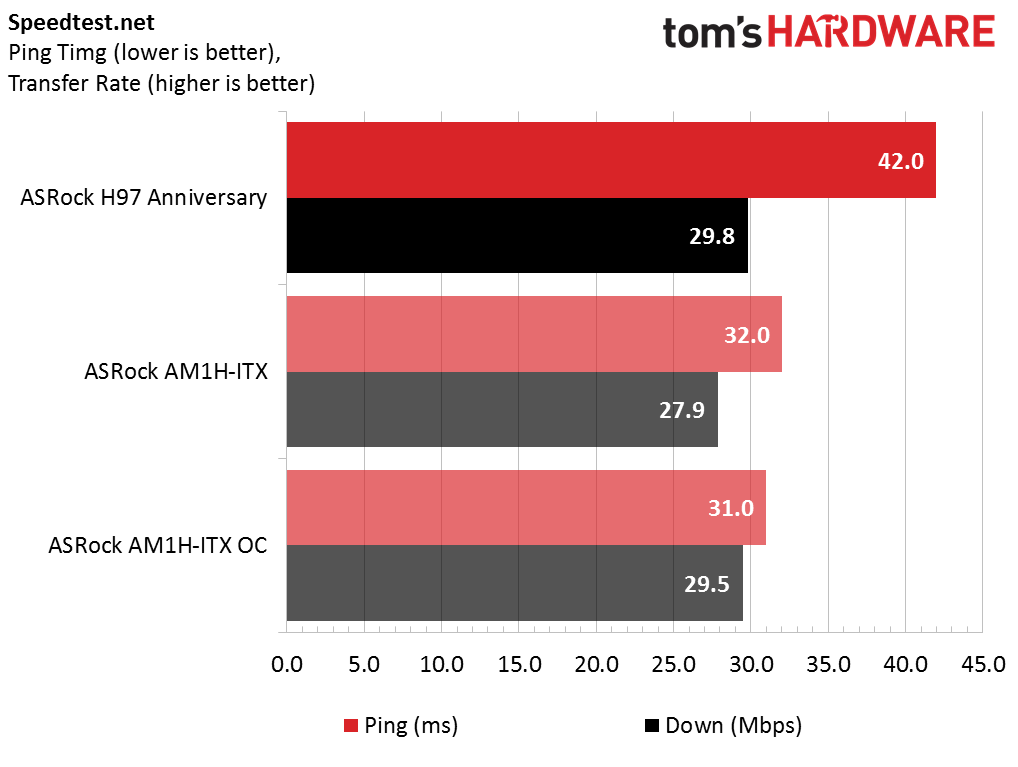O/C Tech: Making AMD's Socket AM1 Viable
Test Results And Analysis
Once again, although I'm going to show some comparative data to a H97+G3258, it should already be obvious that it will not be an apples-to-apples comparison. Performance differences are generally very large, but some of them are indeed interesting. I did plug this into my test-bench UPS during the tests, so as usual 6W should be subtracted from the power usage numbers.
| Benchmark Settings | |
|---|---|
| Synthetic Benchmarks and Settings | |
| PCMark 8 | Version: 2.3.293, Work, Home, and Creative Benchmarks |
| SiSoftware Sandra | Version: 2015.01.21.15, Memory Bandwidth |
| Crystal DiskMark 3.03 | Sequential Read |
| Unigine Heaven 4.0 | Version 4.0, Built-in Benchmark DirectX 9, Low Detail, 1280x720, 2xAA, No Tessellation DirectX 11; High Detail, 1280x720, 0xAA, No Tessellation |
| Game Benchmarks and settings | |
| Plants vs. Zombies | Retail |
| Guild Wars | All settings maxed except AA |
| Guild Wars 2 | Autoselected settings, mostly Medium; more High than Low, FXAA |
Lo and behold, the Athlon 5350 can indeed be overclocked on the ASRock AM1H-ITX. Initially, I didn't see overclock settings, but I had read they should be there, so I flashed the BIOS. Sure enough, an OC Tweaker page became available. The 2.3GHz setting was stable, but 2.4GHz was not with this particular RAM. I tried another set of faster RAM: G.Skill's F3-2133C10D-16GSR, and found that stable at 2.4GHz. That RAM is for another system, however, so all of my overclock tests are at 2.3GHz. If you want more though, it can be done, possibly with faster RAM.


Looking at the RAM page, I have no doubt that a more determined overclocker can do better than I did.
Performance Benchmarks
All of the PCMark8 benchmarks ran without issues on the AM1 test platform. As you can clearly see, though, it is no match for the G3258, even taking advantage of accelerated processing with the GTX 750 Ti. (Even here, cheaters never win.)
Once again, the dual-core G3258 blows the quad-core Athlon 5350 out of the water. Not that it matters much, but it is worth noting that the RAM runs in single-channel mode on the AM1 platform, even with two modules installed. Overclocking provided a visible boost, but it still does not begin to catch up.
Well, what have we here? The little AM1 system keeps up with the Pentium rather nicely. I'd say "beats," and truly it does, except that remember: Different drives are being measured here. The only conclusion to be drawn here is that AM1's SATA interface is not gimped. The USB 3.0 speeds drop off considerably when the system is overclocked. This behavior has reared its head before, and if I'm not mistaken, a forum contributor suggested that the USB 3.0 port dropped back to USB 2.0 speeds in this situation.
On its own, the integrated video of the Athlon 5350 cannot hold a candle to the GT730 used with the Pentium system. Add the GTX 750 Ti, though, and the GT730 is left in the dust, even with a much faster CPU behind it. In a moment, we'll see if this matters in some actual games.
Get Tom's Hardware's best news and in-depth reviews, straight to your inbox.
I actually found this a little disappointing; I was hoping for better. The power numbers look pretty good, until you remember that the H97 system is, at all times, also including a GT730. Even if that card draws half of what the GTX750Ti needs at idle, it looks like the H97/Pentium combination will put up similar numbers at idle, where PCs spend most of their time. Although the PSUs are also different, both are 80 Plus Gold, so there should not be more than a few percentage points of difference between them.
It is worth noting that the use of a DC adapter should cut this down, but the Heaven numbers suggest that the GTX 750 Ti may reach or exceed the maximum a 90W adapter can provide. In fact, ASRock states that DC power won't support a graphics card. It looks like I may need to get one to see if it works, although I may not have the means to measure the power draw. Another minor influence is that the AM1H-ITX also has its SSHD installed, as well as two low-speed fans (one of them with LEDs), whereas the open testbed case used in my previous reviews includes no fans other than the CPU fan, and no other drives are included. This system is definitely frugal, but it may be little better than a similarly configured Pentium system, which provides much better performance in most tasks.
There are reasons why there is no CPU temperature chart. For one, HWMonitor reads the sensors on the AM1H-ITX very differently than it does on the H97 board. Although all of the LGA 1150 systems I've tested showed idle temps around 29 to 30 degrees Celsius (84 to 86 degrees Fahrenheit), on the AM1 board, I was seeing 19 C (66 F). Whereas the Intel machines climbed into the upper 70s (170s F) under a Prime95 load, I don't recall seeing HWMonitor reporting the Athlon 5350 going over 39 C (102 F). Since the onset of winter, the ambient temperature in the test area is now notably lower than it was when I was running LGA 1150 tests. Still, it shouldn't be lower than around 20 to 21 C (68 to 70 F), making the numbers too suspect to report. I will mention that at no time could I hear the tiny CPU fan (including during Prime95), nor feel heat coming from the rear exhaust. The Pentium's fan became audible (although not obnoxious) during these tests.
This should be the last time Speedtest results will appear in one of my reviews. I have obtained a five-port switch, and will be running future LAN throughput tests against a nonsystem SSD installed in a target machine on this switch. The numbers shown here, though, are unremarkable. The higher ping of the Intel-based system is likely due to one of the many confounding factors I cannot control, particularly since both boards use the same Realtek 8111GR interface. If anything, the similar download speeds may only indicate the absence of gimp.
Gaming
Ah! How viable is the Athlon 5350 for games? When I built this PC, gaming was a very low priority; I planned for the possibility that it would be used in a semi-off-grid or alternative-energy (e.g., solar power) environment, in which its ability to play games might not be relevant. Still, we could all use a little fun sometimes… All gaming tests were played on a 1600 x 900 screen, at that resolution.
This is very surprising, and my subjective observations will be needed to provide some context. In "Plants vs. Zombies," I played the Slots minigame to generate an increasing number of mobs. It starts out well enough, but when there are waves of zombies — especially toward the end, when there are also a lot of plants — the game jitters very noticeably. I found it annoying and barely sufferable. I was surprised by the low performance in such a casual game. Overclocking didn't make much of a difference. It is interesting to note that I was not able to select the "3D" checkbox in PvZ, as the game reporting my video card did not meet the minimum requirements. It's odd, but I suspect it is because the PCIe slot is served by only four lanes.
Having been temporarily relocated into my primary system when its GTX970 died recently, the GTX 750 Ti does allow the 3D box to be checked on that machine. "Guild Wars," on the other hand, was very different. Don't let the minimum frame rate in "Guild Wars" alarm you; that was apparently only in zone transitions, because I never saw it while actually moving around and fighting. In a zone, play was smooth. I took a necromancer in a long loop outside of Yak's Bend, in order to get lots of mobs on screen. Even with the maximum of 10 minions, along with perhaps four to eight opponents, the game remained smooth at all times. All settings were maxed. Performance was good enough that overclocking didn't make much difference.
In "Guild Wars 2," I took a Ranger with a pet on a loop outside the crafting area in Metrica Province, doing a little killing with skills using different effects. I was surprised at how smooth it was, although performance was notably better when the system was overclocked. I believe it's also worth noting that to get there the first time, he had to deal with a local event in which there were a number of other players and lots of mobs present, and the game never jittered, although I did see some lag a couple of times. I had used the presets, which were mostly medium; I thought the game looked good. Overall, I got better results than I expected in "Guild Wars 2," and would consider it enjoyable. Still, having played this game on an i3 system with an HD7750 and an i5 with an HD7770, I can tell you that a stronger CPU absolutely matters for this game.
Office Tasks
I do not have benchmarks for these programs. My test here was to use this system to write an earlier review article. Other than displaying some charts on another system while I wrote about them on the AM1 machine, I probably did 99 percent of the work on that article with the overclocked Athlon 5350 on my AM1H-ITX. The only task that seemed slow was Web browsing. Word, Excel, Paint and Picasa responded quickly enough that I might not have noticed a difference if I weren't looking for it. Firefox, however, did experience frequent lag, and is the primary reason I ultimately did not keep using Scrooge as my primary system other than for games (and I did indeed play a fair amount of "Guild Wars" on it).
Cost
Did I mention that this platform is cheap? Although the AM1H-ITX is $49, other AM1 boards cost as little as $35, including ASRock's other mini-ITX offering that also has four SATA 6Gb/s ports (all other boards currently available at Newegg include only two). The cheapest mini-ITX Intel board at Newegg right now, a B85, is $69. Although it, too, has only two SATA 6Gb/s ports, it also has a pair of SATA 3Gb/s ports, which will offer similar performance in many cases (e.g., with an optical drive or even a mechanical HDD). The Athlon 5350 is only $49, compared to $70 for the G3258. Still, you'll need a video card in order to match a Pentium's performance, and the price difference of about $41 will cover only up to about an HD6450 or R5 230, which are still not gaming cards.
Conclusion
I really want to like this platform. It arguably meets most of my needs, for a lot less money and by using a lot less power than my primary rig (a Haswell i5 on a Z97 board with a GTX970). Looking at that phenomenal hardware disparity, it says more about what I've been doing (or not doing) with a PC lately than it does about the relative strength of AMD's 25W Kabini on ASRock's AM1H-ITX. And it does not quite meet all of my needs, or it leaves me wanting more. For power-limited environments, a laptop may work better, although it will also cost more (especially if you need multiple drives, possibly external units).
Unfortunately, objectivity demands that I grit my teeth and admit that this platform may not be your best choice in almost every case. If, however, you do decide to build a general-use AM1 machine (i.e., not a kiosk or other single-function system), the AM1H-ITX and the AM1B-ITX, both from ASRock, are, in my opinion, the only motherboards you should consider, due to their four SATA ports versus competitors' mere two. Otherwise, backing up, cloning a drive onto a bigger one or adding a data drive become either very slow (using an external drive) or impossible. For that reason, if you've already decided on AM1, then I can recommend this board. It would be perfectly suitable for a kid's homework machine or an HTPC.
I'd like to believe this article has provided a couple of useful data points, even if it is only to define that bottom edge to which most people won't want to drop. But if you're looking for some inexpensive fun with something you can tweak, by all means, have at it. If that is your goal, I do not believe you will have wasted your time or money.
Final Verdict
Although it's a fun build, at the end of the day, AMD's socket AM1 is not quite as practical as I had hoped. It was a good experiment; the system is viable, I'm glad I bought it and I will continue to use it (rebuilt with a low-profile GT740 in a smaller case; it has since become the target system in my new LAN speed tests, and I can still max GW1 on it; the excellent Neutron will also be reused), but most people will need something more powerful, particularly if their uses include gaming.
MORE: Intel & AMD Processor HierarchyMORE: All CPU Content
MORE: Best MotherboardsMORE:
How To Choose A MotherboardMORE: All Motherboard Content
Joe Trott is an Associate Contributing Writer for Tom's Hardware, covering Motherboards.
-
SirNathan I like your article, but wanted to point out that there's a similarly-priced Intel board available with a Celeron included and 4 SATA ports http://www.newegg.com/Product/Product.aspx?Item=N82E16813135350Reply
or this slightly more expensive model http://www.newegg.com/Product/Product.aspx?Item=N82E16813157494 -
quilciri I really want to like the AM1 platform as well, but as far as meeting usage needs, I find that it is surprisingly squeezed between the intel platforms you mentioned and the vastly cheaper/lower wattage raspberry pi 2 (and now 3) systems....or even the Pine 64.Reply
If you're just web browsing, emailing, etc, the pi is adequate. If you need more performance than that, it's likely you need a lot more performance and the AM1 sits in a middle ground there isn't much demand for. It does make a good minimal HTPC for 4K video if you want to run windows on your HTPC, but that's all I can think of. (the just released Pine 64 board supports 4K video playback for much cheaper, but only runs android).
-
salgado18 That was a great read, thanks. I've always wondered what as AM1 all about.Reply
Could you test the system with one more game, maybe a modern one? These games are a bit niche, and it's hard to compare the system to others. Maybe an Unreal Engine game, like Tomb Raider (the first reboot, not the latest game)? -
Onus I would not have thought to use such an old game in my tests, but after writing this up, I also tried Diablo II (that's 2, not 3) on Scrooge, and frame rates were 11-18; essentially unplayable, which is a darn shame. I had hoped to use Scrooge as my "lab assistant," recording data, researching and capturing product screen shots, etc, then playing casual games while waiting for tests to complete.Reply
Regrettably, my gaming time is so limited these days that I have not bought any new games for quite a while.
-
salgado18 Reply17669579 said:I would not have thought to use such an old game in my tests, but I also tried Diablo II (that's 2, not 3) on Scrooge, and frame rates were 11-18; essentially unplayable, which is a darn shame.
That's very unexpected. Why is the system good at 3D online games, but bad at old 2D games?
Do you have any numbers of the A4-6300 in similar workloads? It is very close in price, and is a dual-core 3.9GHz CPU. -
Xaltar I would love to see how the Athlon 5350 holds up against Intel's Celeron N3150. While the Intel is an SoC and the Athlon is socketed I don't see AMD releasing new AM1 CPUs for this platform which essentially means that if you already have the Athlon 5350 (the most powerful AM1 option) it may as well be soldered onto the motherboard as there is no further upgrade path. I suspect the N3150 may actually beat the 5350 across the board, including graphics and TDP.Reply -
Sam Bittermann ReplyI would not have thought to use such an old game in my tests, but after writing this up, I also tried Diablo II (that's 2, not 3) on Scrooge, and frame rates were 11-18; essentially unplayable, which is a darn shame. I had hoped to use Scrooge as my "lab assistant," recording data, researching and capturing product screen shots, etc, then playing casual games while waiting for tests to complete.
Regrettably, my gaming time is so limited these days that I have not bought any new games for quite a while.
Yikes, I would have hoped it would have been able to play at least Diablo 3 on medium settings with a 750 Ti but that cpu just can't feed it fast enough. Great article and thanks for over clocking numbers! -
Onus I believe HardwareSecrets did at least one comparison article (may have been two) with low-TDP Intel SOCs against AM1 systems. For most tasks, the Intel builds were stronger, but for graphics, AMD won.Reply
If there is interest, I'll write up a G4400 system from the same perspective.
-
Epsilon_0EVP Regarding the temperatures, the lower temperature is most likely bugged, since that's a well-known issue with AMD temperature sensors. But the upper temperature may actually be correct at idle. I have seen reports of people running an AM1 APU with no heatsink, and they run just fine. Temps of 40C are still perhaps too low, but this is in fact a very cold chip.Reply -
joex444 The bias here is rather disappointing as the author starts with the belief that the system will work for the targeted needs. We see this with "I really want to like this platform" and "Unfortunately, objectivity demands that I grit my teeth and admit that this platform may not be your best choice." One should treat this like an experiment, offering some reason to test the AM1 platform against a G3258 and explaining what purpose the AM1 may offer. Some experiments are performed to compare the two, then an objective conclusion is written devoid of remarks related to the grittiness of one's teeth or the hopes and desires one had going into the experiment. Then we have the memory test where dual channel vs single channel is compared. Obviously no OC is going to overcome that as you need to double the RAM speed in order to even hit parity.Reply
I'm also confused why they believe a DC adapter instead of PSU would yield lower power usage when a PSU is nothing but an AC -> DC converter. Perhaps the system throttles certain components? It was mentioned two SATA drives may be used. Quite frankly, for a system like this I can't imagine why one would have 3 or 4 drives, even if one is a blu-ray drive for an HTPC. With the USB 3.0 ports, external drives should not be slow, you just need decent external drives.
The gaming is clearly not for this system, but I don't understand the point in comparing a G3258 + GT730 to an AM1 + GTX750Ti. The author claims the latter doesn't bottleneck the GPU, but in order to prove this they should provide numbers for the G3258 + GTX750Ti. Any difference is a sign that the AM1 cannot keep up with the GPU, though it could also be the case that the G3258 bottlenecks it as well.
Also interesting is how on the OC the AM1 platform loses points in the PCMark8 Home test. For what appears to be a 12% OC, that's not expected.







